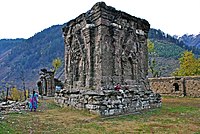 The site consists of the ruins of two temples located in Pakistan's
Salt Range mountains | |
| Location | Khushab District, Punjab, Pakistan |
|---|---|
| Region | Salt Range mountains |
| Coordinates | 32°30′30″N 71°56′12″E / 32.508402°N 71.936538°E |
| Type | Temple complex |
| History | |
| Founded | 9-10th century CE. [1] |
| Periods | Hindu Shahi |
| Cultures | Punjabi Hindu |
The Amb Temples ( Urdu: امب مندر), locally known as Amb Sharif ( Urdu: امب شریف; "Noble Amb"), are part of an abandoned Hindu temple complex on the Sakesar mountain, located at the western edge of the Salt Range in Pakistan's Punjab province. [2] Although foundations go back to the period of Kushan Empire, the temple complex was built in the 9th to 10th centuries CE during the reign of the Hindu Shahi empire. [1] [3]
Location
The ruins are located near Amb Sharef village, on Sakesar mountain in the Soon Valley of Pakistan. The ruins form the westernmost ruins of a string of Hindu temples in the Salt Range mountains that includes the Katas Raj Temples and Tilla Jogian monastic complex.
Architecture
The main temple is roughly 15 to 20 metres tall, and built out of brick and mortar on a square plinth. It is regarded as the "loftiest" of temples built by the Hindu Shahi empire. [4] The temple ruins have three stories, with stairwells leading to inner ambulatories. [5]
The temple is decorated with Kashmiri style motifs on its exterior, including a cusped niche. [5] The structure of the main temple, differs from Kashmiri temples which typically have pointed tops. [5] The main temple is instead similar in style to the nearby Kalar temple, and Kafir Kot temple in Khyber Pakhtunkhwa province. [6]
To the west about 75 metres lies another smaller temple, which is 2 story or 7 to 8 meters high, [7] situated near a cliff. The temple features a small vestibule chamber facing towards the main temple. It was a few metres from a second similarly sized temple, which no longer exists. [5] The entire temple complex was surrounded by a fortification, with the earliest construction at the site dating to the late Kushan period. [5]
Conservation
The site was visited by Alexander Cunningham in the late 19th century, and was partly conserved in 1922-24 by Daya Ram Sahni. [5] The temple had been looted over the centuries, with the last remaining statuary removed from the site in the late 19th century and placed in the Lahore Museum. [5] The site is currently protected by Pakistan's Antiquities Act (1975).
Gallery
-
The main temple
-
The main temple features a Kashmiri-style cusped archway
-
A view of the smaller temple with its vestibule chamber
-
The base of the main temple
-
A view of the main temple's plinth
See also
References
- ^ a b Meister, Michael W. (26 July 2010). Temples of the Indus: Studies in the Hindu Architecture of Ancient Pakistan. BRILL. pp. 29–31. ISBN 978-90-04-19011-5.
- ^ "The forgotten temples | Footloose". The News International.
- ^ Gazetteer of the Attock District, 1930, Part 1. Sang-e-Meel Publications. 1932. Retrieved 21 September 2017.
- ^ Rashid, Salman (2001). The Salt Range and the Potohar Plateau. Sang-e-Meel Publications. ISBN 9789693512571. Retrieved 21 September 2017.
- ^ a b c d e f g Meister, Michael (2005). "Fig Gardens of Amb-Sharif, Folklore and Archaeology". East and West. 55 (1/4). Istituto Italiano per l'Africa e l'Oriente: 201–216. JSTOR 29757645.
- ^ Journal of the Royal Asiatic Society of Great Britain and Ireland. Cambridge University Press for the Royal Asiatic Society. 1903. Retrieved 21 September 2017.
- ^ Amir, Tariq (12 May 2014). "Pakistan Geotagging: Hindu Temple At Amb".








